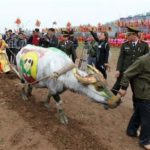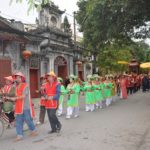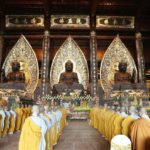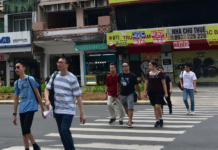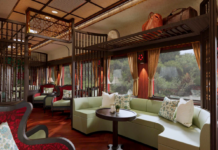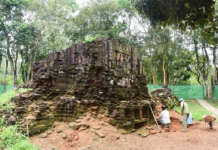The Ba Dinh District has historically held great significance in the political landscape of Vietnam, consistently serving as a focal point for the country’s political and administrative activities. Despite changes to Hanoi’s administrative boundaries, Ba Dinh has maintained its position as the nation’s vital administrative and political hub. Within this district, significant relics from Vietnam’s national resistance wars can be found, further adding to its cultural and historical significance.
The Sacred Land of Extraordinary People
In 1010, King Ly Cong Uan relocated the capital from Hoa Lu to Dai La and bestowed upon it the new name Thang Long. The area known as Ba Dinh today was specifically chosen by the King as the site for the Imperial Citadel, which would serve as the seat of the feudal court and the royal family. This land holds significant historical value as it is regarded as the heart of the ancient Thang Long Citadel.
Ba Dinh, a land of great significance for over 10 centuries, continues to be revered as a place of remarkable individuals. This sacred land serves as a backdrop for momentous national events.
| Thang Long Imperial Citadel is an important historical relic in Ba Dinh District. Photo: The Hanoi Times |
President Ho Chi Minh delivered the historic Declaration of Independence at Ba Dinh Square on September 2, 1945, marking the establishment of the Democratic Republic of Vietnam. This momentous occasion marked the start of a new era for Vietnam, characterized by the steadfast pursuit of both national independence and socialist ideals.
Currently, Ba Dinh District comprises 14 wards and shares borders with Tay Ho, Hoan Kiem, Dong Da, and Cau Giay districts.
National Assembly Chairman Vuong Dinh Hue, during his tenure as the Secretary of the Hanoi Party Committee, emphasized that Ba Dinh holds significant importance as a reflection of the entire nation, making it the epitome of Hanoi’s essence.
Ba Dinh District – Striving for Excellence
Ba Dinh District is committed to fulfilling its assigned tasks with utmost proficiency, reflecting its role as a pioneer. Hoang Minh Dung Tien, Secretary of the District Party Committee, emphasized that the district aims to achieve sustainable economic growth by efficiently harnessing its potential and shifting towards a service-oriented economic structure.
| Ba Dinh District is home to relics from the wars of national resistance. Photo: The Hanoi Times |
Cultural diversity refers to the existence of a variety of different cultures and ethnicities within a society. It encompasses differences in language, religion, customs, traditions, and other aspects of culture. Cultural diversity is a valuable asset, as it promotes understanding, respect, and tolerance among people from different backgrounds. It also encourages creativity, innovation, and a broader perspective in various fields, such as art, music, literature, and business. Recognizing and appreciating cultural diversity is crucial for creating inclusive and harmonious communities that embrace and celebrate the richness of human differences.
Ba Dinh is a historic district in Hanoi, known for its iconic monuments and scenic landscapes. When visiting Ba Dinh, tourists are encouraged to explore significant landmarks such as the Mausoleum of President Ho Chi Minh, the One Pillar Pagoda, and the Thang Long Imperial Citadel.
“The One Pillar Pagoda is a historic Buddhist temple in Hanoi, Vietnam. It was built in 1049 during the reign of Emperor Ly Thai Tong. The pagoda is characterized by its unique architecture, with a single pillar supporting a small, wooden temple. It is considered one of the most iconic and important religious sites in Vietnam.”
| Chua Mot Cot or One Pillar Pagoda is an iconic architecture built in Ly Dynasty (1009-1028). Photo: VNA |
Located in the vibrant city of Hanoi, the lotus pagoda stands as an exquisite testament to both spirituality and culture. Its distinctive architecture, taking the form of a blossoming lotus, is a sight to behold. Truly a symbol of beauty and tranquility, this pagoda holds a special place in the hearts of locals and visitors alike.
The construction of the One Pillar Pagoda commenced in 1049 under the rule of King Ly Thai Tong (1028-1054). According to legend, King Ly Thai Tong had a dream in which he saw Guanyin resting on a lotus flower and extended an invitation to join her. Inspired by this dream, the king shared the tale with the esteemed monk Thien Tue, who wisely suggested the creation of a pagoda featuring a stone pillar resembling a lotus. This singular pillar would serve as a tribute to Guanyin.
Thang Long Imperial Citadel
The Thang Long Citadel stands as a remarkable architectural masterpiece, constructed over generations by the dynasties of Vietnam. It has since become the most significant relic among the multitude of Vietnamese monuments.
The site was officially added to the prestigious UNESCO World Heritage List in 2010. A team of experts has conducted extensive excavations on a vast 19,000m2 area located within the political center of Ba Dinh.
The Imperial Citadel of Thang Long, discovered through the largest excavation in Vietnam and Southeast Asia, showcases 13 centuries of cultural layers and a multitude of relics.
The is a significant historical site located in Hanoi, Vietnam. It is the final resting place of President Ho Chi Minh, the leader of the Vietnamese independence movement and the country’s first president.
The Ba Dinh complex of historical and cultural relics includes the Presidential Palace, Ho Chi Minh Mausoleum, and Ho Chi Minh Museum.
Tourists from both within Vietnam and around the world flock to Ho Chi Minh City to pay homage to Ho Chi Minh, a revered figure in the country’s struggle for liberation and a symbol of its rich cultural heritage.
Painting contest held for buffaloes joining ploughing festival in Ha Nam
A buffalo painting contest for the Doi Son Tich Dien (ploughing) Festivalwas held on February 10, or the sixth day of the Lunar New Year in Doi Son commune, Duy Tien district, the northern province of Ha Nam.




